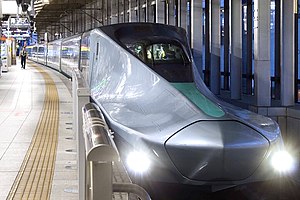|
ALFA-X
The Class E956 (E956形), branded "ALFA-X", is a ten-car experimental Shinkansen train operated by East Japan Railway Company (JR East) in Japan to test technology to be incorporated into future trains operating at speeds of up to 360 km/h (225 mph). The name is an acronym for "Advanced Labs for Frontline Activity in rail eXperimentation".[1] The first train was unveiled on 9 May 2019.[2] Its test run is mainly performed in sections between Sendai and Shin-Aomori of the Tohoku Shinkansen line, and, in some cases, on the Hokkaido Shinkansen line. DesignThe experimental trainset is being tested at speeds of up to around 400 km/h (250 mph) to evaluate new technologies to be incorporated into new trains to operate in revenue service at speeds of up to 360 km/h (225 mph).[3] These technologies include dampers to reduce vibration and the likelihood of derailment in major earthquakes.[3] It also tests body designs that reduce snow adherence.[3] The E956 train evaluates two different end car nose profiles, just like the earlier Fastech 360.[4] The nose of car 1 is 16 metres (52 ft 6 in) long, and is a brand new design, while the nose of car 10 is similar to the E5 Series Shinkansen and H5 Series Shinkansen, but is 22 metres (72 ft 2 in) long, with only 4.5 metres (14 ft 9 in) remaining for passengers with three rows of seating.[5] The different nose profiles on Car 1 and Car 10 were designed to compare air resistance and impact noise caused by pressure waves when the train enters and exits tunnels. Car 10's nose was designed to minimize noise. Each passenger car prototype has different window shapes, to test wind resistance for each type of design.[6] The E956 features eddy current brakes and an aerodynamic braking system attached to the car's roof, called air brakes or spoilers.[7] Two types of pantographs are also being evaluated on the train, to test for noise and wind resistance.[6] Noise reduction has proven to be a major challenge in the design and operation of the trains; a test centre evaluates simulated train noises generated by speakers, used to design walls on the elevated track sections of the line for the purposes of noise reduction. A designer explains that this is a major hurdle that must be overcome before the higher speed train can be deployed. Newer sound dampening polyester panels held in place by steel casings are attached to walls along the track; they are also weatherproof (as older designed absorbed water when raining or snowing, limiting their effectiveness). As of April 2023, there are also several design features that they were not sharing with the public, to avoid releasing their technical research.[6] HistoryJR East officially announced its plans to build a ten-car ALFA-X test train on 4 July 2017, to be delivered in spring 2019 for extensive testing and evaluation.[1] The finished train was unveiled on 9 May 2019.[2] The train reached a speed of 320 km/h (200 mph) in May 2019, matching the top operating speed of the fastest services on the line.[8] By June that same year, the train was regularly measured to be running at 360 km/h (225 mph) by rail enthusiasts.[9] The train was first observed running at the announced top planned test speed of 400 km/h (250 mph) on 14 December 2019.[10] The Plarail (series of toy trains) "Ippai Tsunago" Shinkansen Test Train ALFA-X began to be sold on 26 December 2019.[citation needed] The train was observed in Hokkaido for cold weather testing on 12 February 2020[11] and 3 February 2021.[12] The train reached a speed of 382 km/h (237 mph) on 27 October 2020, setting the new speed record trains running commercially.[13] In January 2025, The Hindustan Times reported, citing anonymous sources, that the production version of the ALFA-X, know as the E10, may simultaneously enter service in Japan and on the Mumbai-Ahmedabad high-speed rail corridor in 2029 or 2030.[14] References
External links
|
||||||||||||||||||||||||||||||||||||||||||||




